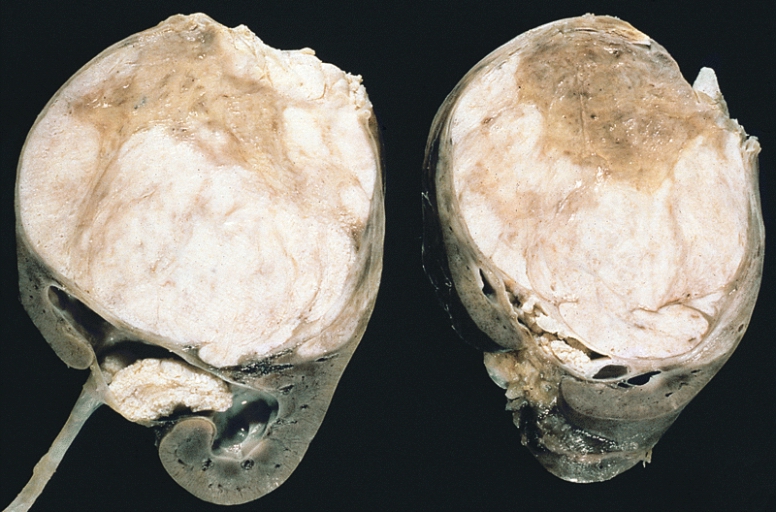Playlist
Show Playlist
Hide Playlist
Wilms Tumor
-
Slides WilmsTumor Pediatrics.pdf
-
Download Lecture Overview
00:01 In this lecture, we will review the Wilms tumor, which is a renal tumor in children. 00:06 This is basically a kidney tumor arising from pluripotent embryonic renal precursor cells. 00:12 This represents about 5 to 7% of pediatric malignancies diagnosed each year and its peak age of diagnosis is around 2 to 3 years of age. 00:24 So, this tumor is associated with multiple genetic syndromes including the Beckwith-Wiedemann syndrome, as well as WAGR syndrome which is Wilms, Aniridia, GU abnormalities, and mental retardation. 00:38 Also, it's associated with the Denys'Drash syndrome which is pseudohermaphroditism and degenerative renal disease and the WT1 and WT2 gene mutations which are vital to kidney development and this represents about 20% of cases. 00:56 So, to diagnose the Wilms tumor, we'll do a good history, a physical exam, and get some imaging. 01:02 From a historical perspective, there's generally a history of a painless abdominal mass. 01:08 It doesn't usually hurt. 01:09 Patients may have nausea or vomiting. 01:11 They may experience weight loss. 01:13 They may have lethargy and fatigue. 01:15 They may notice abdominal pain or distension but it'll be non-specific, not on the mass, and what's key is they'll often have gross hematuria. 01:25 So, a child with gross hematuria at the age of 2 to 3, that's something we're worried about. 01:30 Next, we'll do a physical exam. 01:32 So, this should be a painless, palpable, firm, fixed abdominal mass. 01:37 It is a friable tumor however, so you should be cautious when palpating the abdomen if you know this patient has a Wilms or if you suspect it might be a Wilms as with rough palpation, the tumor may rupture. 01:50 The patient may also have hypertension as associated with this disease. 01:56 They may have pallor or they may have a varicocele or an inguinal hernia. 02:02 Additionally, they may have abdominal vein distension and you may see potential stigmata of those other genetic syndromes we mentioned before. 02:11 Next, if we suspect the disease, we'll do some diagnostic imaging. 02:17 First, regarding lab findings, we'll often get a CBC with differential. 02:22 What's unique about this tumor is patients may present with polycythemia from increased epo expression from the tumor. 02:31 Patients will also have hematuria, so a urinalysis is indicated, and then we'll generally do a biopsy to confirm the diagnosis. 02:39 We would usually image them prior to biopsying to verify the presence of a tumor and typically what we'll see is something like this, which is a large tumor showing characteristic mixed tissue densities, cystic and solid, and arising from the kidney and enveloping a remnant of normal renal tissue. 02:58 So, it's generally found on imaging though with a renal ultrasound. 03:05 That's usually our first choice for how we image these patients and then, we'll get a CT scan of the chest, abdomen and pelvis for staging purposes and for further characterizing the lesion, although ultrasound is usually how we first make the diagnosis. 03:20 Then, we will provide multimodal therapy depending on the stage and histology of the tumor. 03:27 So we will usually surgically resect these, we may do radiation, and we may also do chemotherapy. 03:35 Generally, the prognosis for this disease is very good depending on stage of disease. 03:41 So, for stage I disease, event-free survival is upwards of more than 95%. 03:48 It has a great prognosis. 03:49 Stage II or III, 80 to 95%, and even stage IV disease has a 75% event-free survival. 03:57 So that's my review of Wilms tumor in children. Thanks.
About the Lecture
The lecture Wilms Tumor by Brian Alverson, MD is from the course Pediatric Oncology. It contains the following chapters:
- Wilms Tumor
- Physical Exam Findings
- Multimodal Therapy
Included Quiz Questions
Which of the following is NOT an association of Wilms tumor?
- CHARGE syndrome
- Beckwith-Wiedemann syndrome
- WAGR syndrome
- Denys-Drash syndrome
- WT1 WT2 gene mutations
Which of the following is NOT true regarding Wilms Tumor?
- It does not metastasize.
- Median age at diagnosis is about 3 years.
- It commonly presents as an asymptomatic abdominal mass.
- Patients may have polycythemia.
- Patients may have gross hematuria.
Which of the following is used to confirm a suspected diagnosis of Wilms tumor?
- Biopsy or surgical resection of the lesion
- Bilateral renal ultrasound
- Renal CT scan without contrast
- Renal CT scan with contrast
- Magnetic resonance imaging
Customer reviews
5,0 of 5 stars
| 5 Stars |
|
1 |
| 4 Stars |
|
0 |
| 3 Stars |
|
0 |
| 2 Stars |
|
0 |
| 1 Star |
|
0 |
Excellent lecture as usual. Very easy to understand and remember. Thanks a lot!




